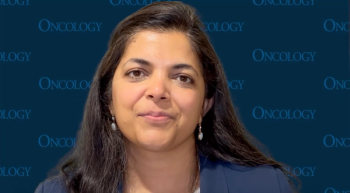
- ONCOLOGY Vol 16 No 3
- Volume 16
- Issue 3
Mantle Cell Lymphoma: High Rates of Complete Remission and Prolonged Failure-Free Survival With Rituximab/Hyper-CVAD Without Stem Cell Transplant
Previously untreated mantle cell lymphoma (MCL) is an uncommon disorder with a poor prognosis when treated with CHOP-like (cyclophosphamide [Cytoxan, Neosar], doxorubicin HCl, vincristine [Oncovin], prednisone) regimens. Typically the complete remission (CR) rate is 20% to 30%, median failure-free survival (FFS) is 10 to 16 months, and median overall survival (OS) is 3 years.
Previously untreated mantle cell lymphoma (MCL) is an uncommon disorder with a poor prognosis when treated with CHOP-like (cyclophosphamide [Cytoxan, Neosar], doxorubicin HCl, vincristine [Oncovin], prednisone) regimens. Typically the complete remission (CR) rate is 20% to 30%, median failure-free survival (FFS) is 10 to 16 months, and median overall survival (OS) is 3 years.
Using the hyper-CVAD (fractionated cyclophosphamide, doxorubicin, vincristine, dexamethasone)/methotrexate/cytarabine regimen, which includes stem cell transplantation, in patients less than 66 years old, we previously described a CR rate of 100% as well as prolonged FFS and OS (J Clin Oncol 16:3803, 1998). In March 1999 we started a new trial using the same hyper-CVAD regimen but with two major modifications: (1) we added rituximab (Rituxan) at 375 mg/m² on day 1 of the first six courses, and (2) we stopped doing stem cell transplantation for patients who achieved CR within six courses of treatment.
Pretreatment requirements included diagnosis of untreated MCL (nodular, diffuse, or blastic variant) as well as adequate organ function. There was no Ann Arbor stage or age restriction and patients with leukemic presentation were eligible. Patients with HIV infection or evidence of central nervous system disease were excluded. A total of 92 patients have been registered. Median age was 61 years and 100% were stage IV. Involvement of the spleen, bone marrow, and peripheral blood was present in 39%, 92%, and 47% of patients, respectively. Systematic upper and lower endoscopies showed that 88% had involvement of the gastrointestinal tract. Diffuse histology was present in 71%, 16% of which had a blastic variant. Fifty-nine patients have had at least six cycles and will be used as the denominator for response assessment.
With a median follow-up of 14 months, results after six cycles of chemotherapy are summarized in the table above and compared with prior regimens. There were no statistically significant differences in outcome. Toxicity was mainly hematologic (60% grade 4), and there were 11% grade 3 infections.
CONCLUSION: Our current results with R-HCVAD confirm our previous experience with hyper-CVAD when compared with CHOP. In this study, R-HCVAD without stem cell transplantation appears equivalent to hyper-CVAD in patients younger than 66 years old. These results are preliminary, and more follow-up is needed.
Articles in this issue
almost 24 years ago
Single-Agent Rituximab in Early-Stage Chronic Lymphocytic Leukemiaalmost 24 years ago
Recruitment for Trial of Adjuvant Trastuzumab Under Wayalmost 24 years ago
Rituximab in the Treatment of Acquired Factor VIII Inhibitorsalmost 24 years ago
Support for New Medicare Pay Formulaalmost 24 years ago
Irinotecan-Containing Regimen Improves Survival in Small-Cell Lung CancerNewsletter
Stay up to date on recent advances in the multidisciplinary approach to cancer.

















































































